《1 Introduction》
1 Introduction
China has actively participated in global economic cooperation, proposed strategies to accelerate economic development, and isolated strategic emerging industries as an important direction for industrial transformation and advancement. The objective evaluation of the status of emerging technology research and industrialization development, comprehensive and accurate grasping of industry maturity laws, and reasonable predictions of development trends have become important topics in emerging industry development planning.
The maturity level has become an effective method for evaluating and measuring the state of industry development. The concept originated from the technology readiness levels (TRL) study conducted by the National Aeronautics and Space Administration (NASA) in the 1970s [1]. Currently, the evaluation standards of TRL are mature, and the assessment methods and implementation procedures have also been standardized [2]. Domestic and foreign scholars have extended the evaluation method of TRL to the fields of products and market economy. Since 2003, China’s aerospace industry has studied product readiness levels (PRL) [3] to adapt from single-piece production to small-batch production. Considering the particularity of aerospace products and the problems associated with the development of small samples, an 8-level frame model of aerospace products was constructed. According to the actual needs of engineering development, assessment methods such as manufacturing readiness levels (MRL) [4], integration maturity [5], software capability maturity [6], and workforce maturity [7] have been developed.
According to the existing literature [8], researchers have deepened exploration and theoretical development of the TRL, MRL, and PRL, proposed the concept of industry maturity level, and established an assessment model of industry maturity level by combining qualitative and quantitative methods. First, the maturity level of technology and manufacturing has been assessed and integrated with other factors to obtain the PRL. Then, the PRL has been combined with the evaluation results of market maturity levels (MML) to form a comprehensive assessment result of the industry maturity level. In a series of consulting studies on strategic emerging industries in China [9], the cultivation and development of emerging industries have been supported by completing the assessment of industry maturity with relevant methods, and exploring key factors faced by specific industries, such as constraints, development needs, potential risks, and industry expected maturity time.
In response to increasing global industrial competition, the long-term existence of Sino–U.S. trade friction, and the increasing importance of the autonomous and controllable ability of technology and industry, China urgently needs to build an independent and controllable modern industrial system. However, the original assessment method of industry maturity level exposes certain limitations: the original method focuses on the overall prosperity level of a specific industry in a country and does not consider whether the supply of factors such as technology, equipment, capital, and products in the industry is independent. Therefore, it is difficult for the evaluation results to reflect the security and controllability of a country’s industry. Taking this as a starting point, this paper introduces a new factor, the industry security and controllability level (ISCL), which comprises autonomous and controllable ability and industry-leading capability. Furthermore, a new assessment model for the industrial system maturity level is constructed, evaluated, and applied to many emerging industries.
《2 Assessment method of industrial system maturity levels》
2 Assessment method of industrial system maturity levels
《2.1 Model structure》
2.1 Model structure
In this paper, an assessment indicator called the ISCL, based on the basic framework of the industry maturity level model [8], as well as strategic needs and requirements for accelerating the construction of an autonomous and controllable modern industrial system, is introduced to build an assessment model of the industrial system maturity (Fig. 1). It should be noted that the TRL, MRL, PRL, and MML have not been adapted from their original forms.
《Fig. 1》

Fig. 1. Architecture of the assessment model of the industrial system maturity levels.
The ISCL is used to measure and evaluate the degree of industry security and controllability according to two aspects: autonomous and controllable ability and industry-leading capability. The assessment of autonomous and controllable ability involves core raw material autonomy level, core technology autonomy level, key infrastructure equipment autonomy level, and domestic capital autonomy level. The assessment of industry-leading capability involves domestic brand market influence, domestic product sales dependence on foreign exports, and industry standard setting ability. The specific evaluation criteria of ISCL are shown in Table 1.
《Table 1》
Table 1. Indicators and definition of ISCL.

《2.2 Indicator integration relationship》
2.2 Indicator integration relationship
The assessment model of the industrial system maturity level covers the 4-level integration relationship of the ISCL, PRL, industry maturity level, and industrial system maturity level: (1) the ISCL is obtained by integrating autonomous and controllable ability and industry-leading capability, and is divided into four levels: very weak, weak, medium, and strong (Table 2); (2) PRL is derived from the integration of TRL and MRL, and can be divided into five levels: level 1 (conceptual product), level 2 (laboratory product), level 3 (engineered product), level 4 (demonstration product), and level 5 (market product) (Table 3); (3) Industry maturity level is derived from the integration of PRL and MML, and can be divided into four levels: level 1 (emergence), level 2 (cultivation), level 3 (development), and level 4 (mature) (Fig. 2); (4) Industrial system maturity level is derived from the integration of the industry maturity level and ISCL, and can be divided into four levels: level 1 (emergence), level 2 (cultivation), level 3 (development), and level 4 (mature) (Fig. 3).
《Table 2》
Table 2. Integration relationship of the ISCL.
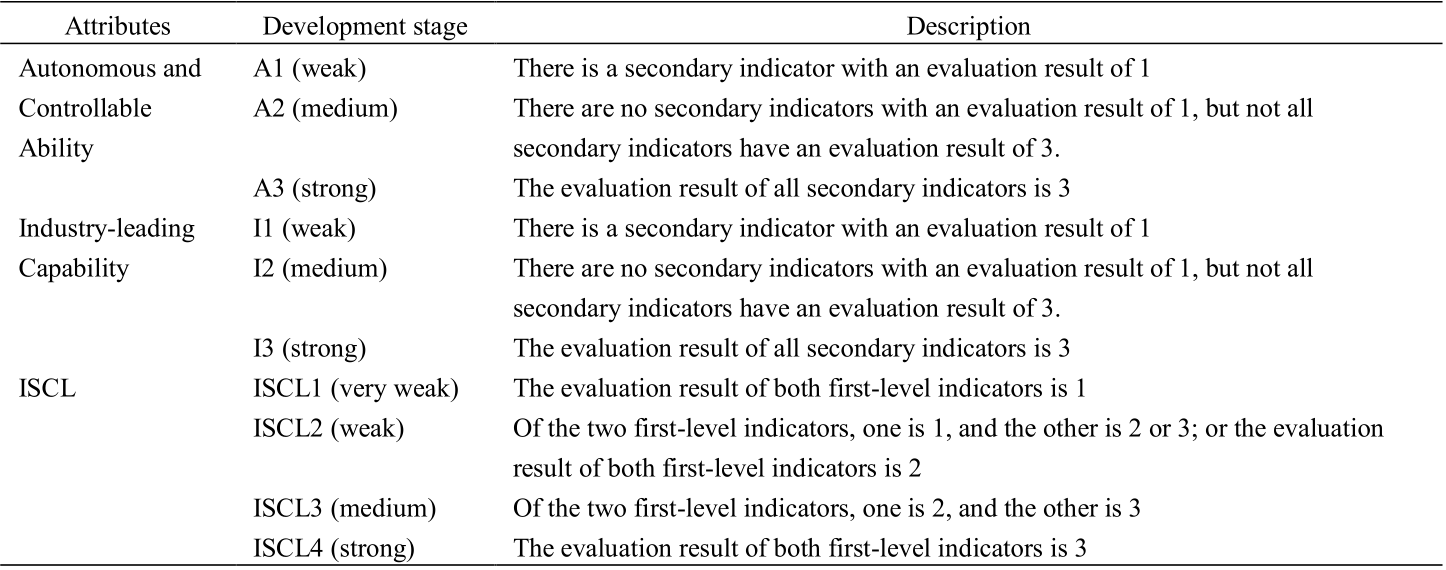
Note : First-level indicators and secondary indicators are defined and shown in Table 1.
《Table 3》
Table 3. Integration relationship of the PRL.
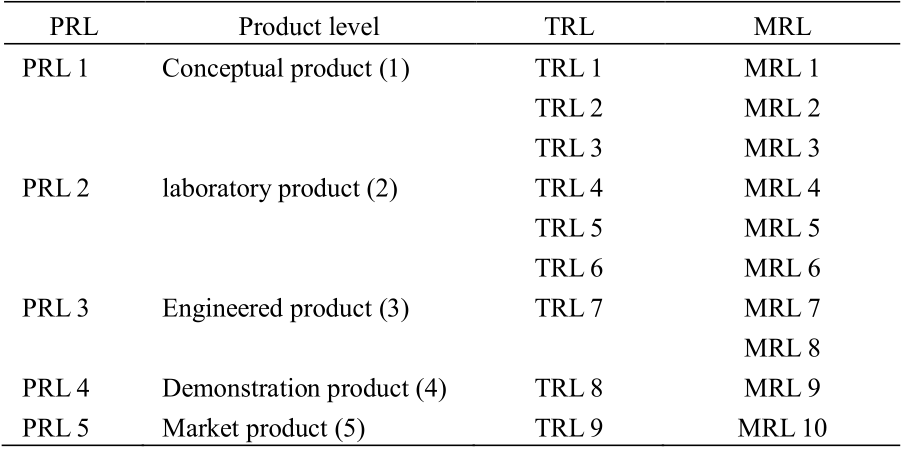
《Fig. 2》

Fig. 2. Integration relationship of the industry maturity level.
《Fig. 3》

Fig. 3. Integration relationship of the industrial system maturity level.
《3 Assessment and analysis for emerging industries》
3 Assessment and analysis for emerging industries
《3.1 Overall assessment》
3.1 Overall assessment
Using the assessment model of the industrial system maturity level, an assessment of the maturity levels of 25 specific industries in six fields including new-generation information technology, high-end equipment, biology, new materials, green and low-carbon, and digital creativity were obtained. The relevant evaluation process is divided into four stages: (1) Propose the goals, ideas, and research methods of the maturity level assessment work, and prepare an industrial system maturity level self-evaluation form; (2) educate and train personnel in using the assessment method of the industrial system maturity level; (3) organize experts in various fields to carry out assessments for certain industries in their fields and fill out the self-evaluation form for the maturity level of the industrial system; and (4) based on the self-evaluation forms in different fields, organize experts to carry out comprehensive assessments and data analysis. The results of the industry maturity level assessment and industrial system maturity level assessment in 25 industries are shown in Table 4.
《Table 4》
Table 4. Results of the industry maturity level and industrial system maturity level of strategic emerging industries in China.
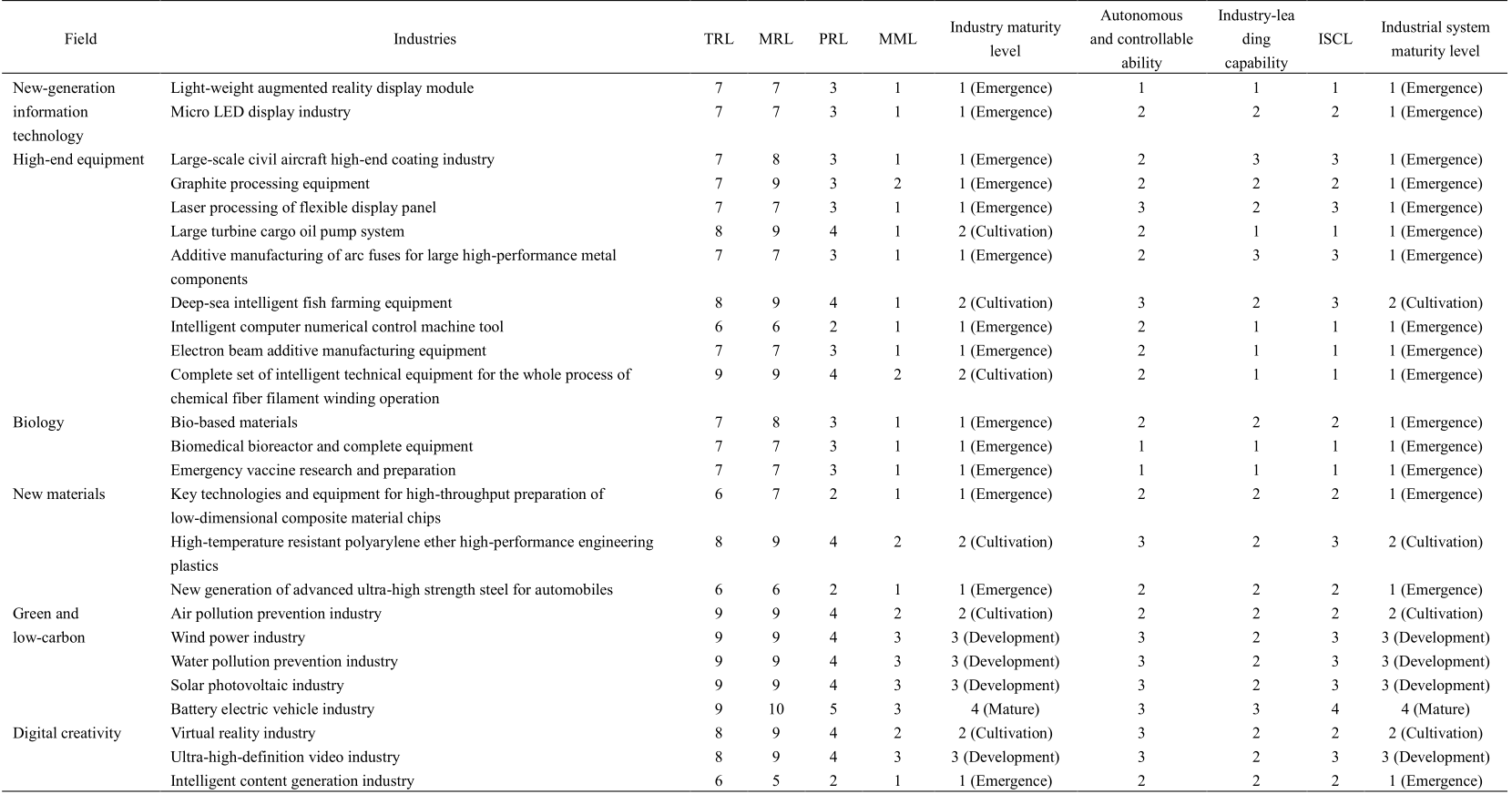
《3.2 Results》
3.2 Results
Among the 25 industries, 14 industries are in the emergence stage and 6 industries are in the cultivation stage. Five industries have entered a higher stage: wind power, water pollution prevention, solar photovoltaic, and the ultra-high-definition (Ultra HD) video industries have entered the development stage, and the battery electric vehicle industry has entered the mature stage. Generally, most industry maturity levels are in the emergence stage and cultivation stage, while the number of industries entering the development and mature stage is relatively small.
Among the 25 industries, 15 industries are in the emergence stage, and 5 industries are in the cultivation stage. Five industries have entered a higher stage: the wind power, water pollution prevention, solar photovoltaic, and ultra HD video industries have entered the development stage, while the battery electric vehicle industry has entered the mature stage. Overall, the development stage of the industrial system maturity of 25 industries is the same as that of the industry maturity of these industries.
The overall assessment results of the ISCL of the 25 industries are not optimistic. Seven industries are assessed as very weak, eight industries are assessed as weak, and nine are assessed as medium. Only the battery electric vehicle industry is assessed as strong. Among the seven industries with very weak evaluation results, three industries, light-weight AR display module, biomedical bioreactor and complete equipment, and emergency vaccine research and preparation, have weak evaluation results in both autonomous and controllable ability and industry-leading capability. The evaluation results of both first-level indicators are weak, indicating that the industrial security is relatively severe. Therefore, it is particularly urgent to strengthen the autonomous and controllable ability and industry-leading capability of these industries.
The key points that need to be addressed in these 25 industries to achieve future development are listed in Table 5. Furthermore, there are 17 industries that urgently need solutions. These industries are selected according to the following criteria: If TRL < 8, MRL < 9, MML < 2, and ISCL < 2, then a solution is needed in the corresponding link. The result of this research combines micro and macro factors, and can be used as a direct reference for industry research and policy-making institutions of strategic emerging industries in China.
《Table 5》
Table 5. Key points need to be addressed in various industries.
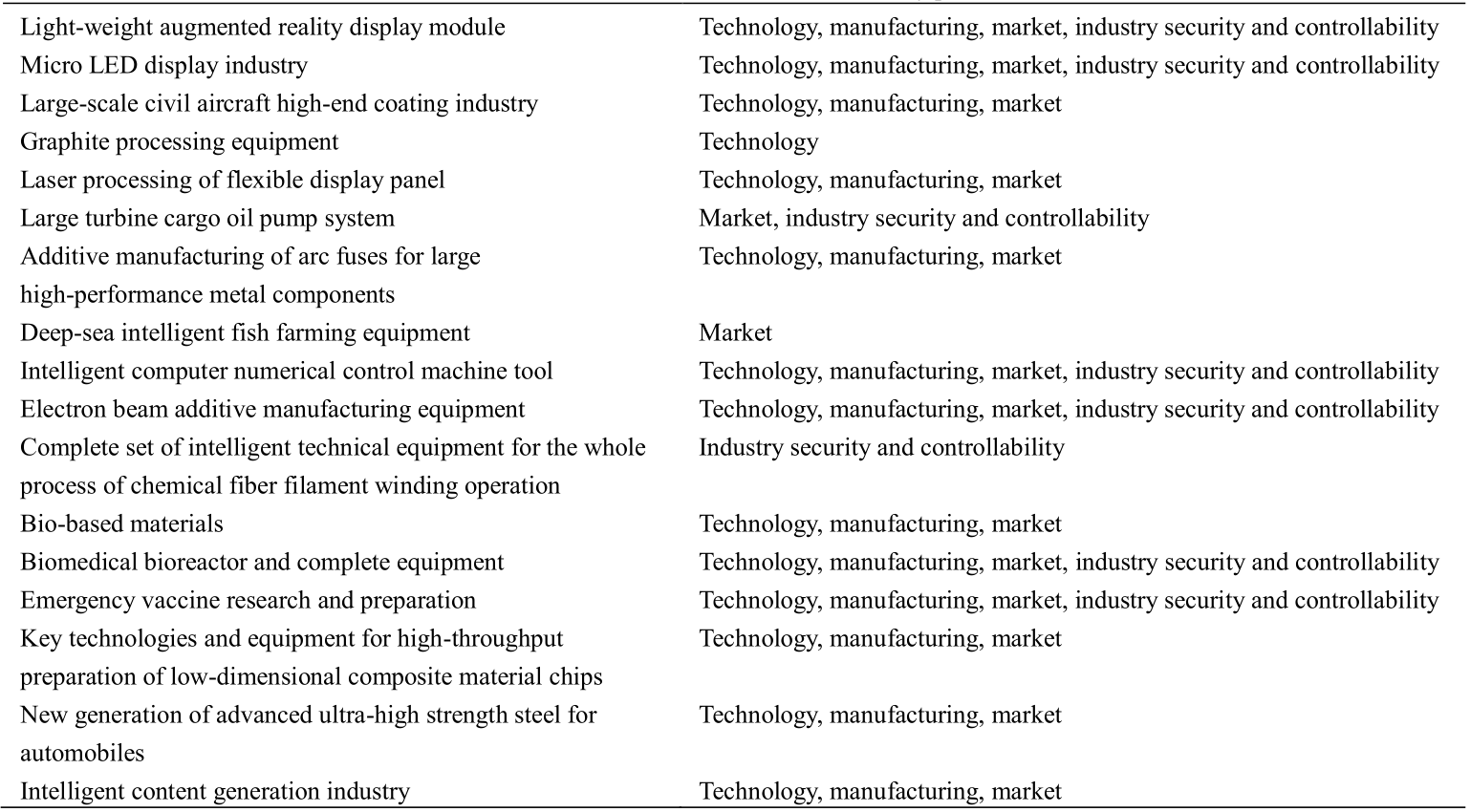
《4 Conclusion》
4 Conclusion
In this study, the concept of an industrial system maturity level is proposed and a new factor for evaluating the industry security and controllability level, including autonomous and controllable ability and industry-leading capability, is introduced. The corresponding evaluation results can reflect the basic status of a country’s industrial security and controllability. An analysis of the industrial system maturity levels of 25 emerging industries in China shows that the number of industries in which the industrial system has entered the stage of development or maturity is relatively small, and the ISCL of most industries is poor. This conclusion provides new theoretical support for the optimization of strategic emerging industries in China.
Industries with poor ISCL performances should focus on strengthening the core raw material autonomy level, core technology autonomy level, key infrastructure equipment autonomy level, and domestic capital autonomy level to enhance the industry’s autonomy controllability and solve the problem that restraining the development. These industries should also enhance their industry-leading capability by focusing on enhancing the influence of the domestic brand market, reducing the dependence of domestic product sales on exports, and strengthening the industry standard-setting ability. For industries with a relatively high technology and manufacturing maturity level, while improving industry security and controllability, it is advisable to promote commercial demonstration applications, increase policy support to promote market-oriented development, and encourage technological innovation to accelerate the transformation from scientific and technological R&D achievements to large-scale commercial applications.

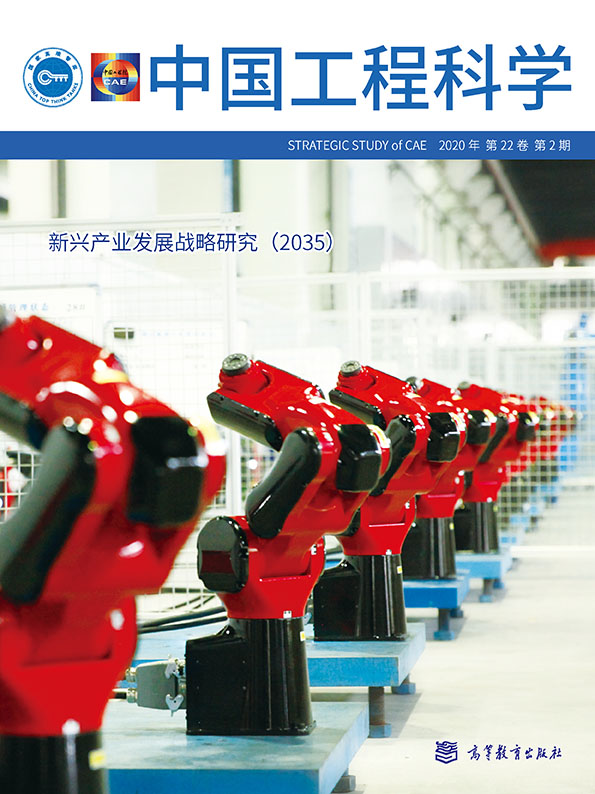












 京公网安备 11010502051620号
京公网安备 11010502051620号




